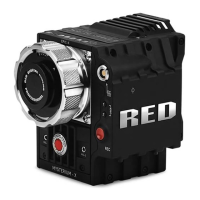COPYRIGHT © 2014 RED.COM, INC
RED DSMC OPERATION GUIDE
955-0020_V5.1, REV-H | 44
Basic Menus are the menus that are available at the top row of the display screen. The Basic Menus include:
Frame Rate (FPS), ISO (Sensitivity), F Stop, Exposure, White Balance, Resolution, and REDCODE (Quality).
This section gives an overview of each of the Basic Menus, and directs you to the corresponding sections in
the “Advanced Menus” chapter for more information.
ACCESS ADVANCED MENUS FROM BASIC MENUS
Except for the REDCODE menu, you can select the Advanced... button to access the related settings in the
Advanced Menus.
For example, if you open the Resolution menu and select Advanced..., the camera takes you directly to the
Settings > Project > Format screen, where you can modify the resolution, aspect ratio, anamorphic setting, and
lookaround setting.
EDIT LIST FEATURE
In each Basic Menu, you can select the Edit List... button to change the values that display for each setting.
For example, if you open the Frame Rate menu and select Edit List..., the camera lets you remove or add values
to available Frame Rate values.
FRAME RATE (FPS)
Select the sensor frame rate (also referred to as the capture frame rate). The sensor frame rate is the number of
frames per second (FPS) that are recorded. The sensor frame rate is different from the project time base, which
is the rate at which the footage will be played back.
The default sensor frame rate is 23.98 FPS, or the selected project time base when it is a value other than 23.98
FPS or 24 FPS.
Select the Advanced... button to access the Settings > Project > Frame Rate screen. For more information about
the basic and advanced frame rate settings, as well as the minimum and maximum frame rates for each resolu-
tion, go to “Frame Rate” on page 56.
ISO (SENSITIVITY)
Select the native camera ISO rating. The sensitivity value is adjustable in 1/3 stop increments. When the ISO
rating is adjusted, the camera logs the change as metadata and the monitor path reacts accordingly. Higher
ISO values lead to brighter images in the monitor path, and vice versa.
RED recommends that you set the ISO near 800, then adjust the lens T-stop and lighting or ND filters to match.
The ISO can later be adjusted around one stop for fine-tuning.
The range is ISO 250–12,800, and the default is ISO 800.
Select the Advanced... button to access the Settings > Look > FLUT screen. For more information about these
settings, go to “FLUT” on page 55.
05
BASIC
MENUS

